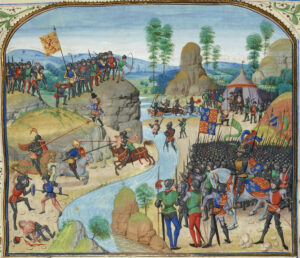A Record-Breaking Find from the Age of William Wallace
So far, a comparatively small number of medieval coin hoards have been found in Scotland. But the hoard that was unearthed now certainly makes up for it: as became known in November 2022, a detectorist came across a coin hoard in a field in the Dumfries and Galloway region in southern Scotland. The archaeologists that were called in recovered a total of 8,407 coins from the ground. According to the chief archaeologists of the Scottish Treasure Trove Unit, it is the largest hoard of medieval coins that has been found in Scotland since the 19th century. Named after a village in the surrounding area, the hoard is referred to as the “Dunscore Hoard”.
Unfortunately, we do not know much more about the find. According to first media reports, the coins are said to be mainly pennies of the English kings Edward I (1239-1307) and Edward II (1284-1327), but Scottish and Irish issues as well as coins from mainland Europe are also believed to be among the pieces. The typical Edwardian Pennies were minted after a large-scale coinage reform that the king implemented in 1279. On the obverse, they show the bust of the respective king from the front and on the reverse a cross with three spheres in every field.
Covid Brought a Blessing of Hoards
We will probably not learn more about the find until the Treasure Trove Unit will have finished recording and identifying all 8,407 coins. Of course, this will take some time. Especially since the authority is said to be overstrained anyway. Why? Because many Scots roamed their beautiful land with metal detectors during the pandemic and the lockdowns! According to the Treasure Trove Unit, the number of detectorists skyrocketed during Covid. This is also reflected by the finds: whereas a total of 1,551 objects were found in the ground in pre-Covid 2019, between January and late November 2022 a total of 12,263 objects were recorded. An impressive increase, even if you do not take the exceptional find of 8,407 coins into account.
Therefore, the authority will be busy for a while, which is why there are still no pictures, detailed information or statements about the hoard’s value. Moreover, no decision has been made as to what will happen to the hoard.
Who Owns the Hoard?
In Scotland, the ownership of treasure finds is regulated as follows: in theory, the ownership of every find passes to the Crown. Once the hoard is completely recorded, the Scottish Archaeological Finds Allocation Panel will draw up an advice that will be given to the King’s and Lord Treasurer’s Remembrancer. Then the Crown and the government decide whether they want to exercise their claim or not. If they do, the hoard will be registered as a national treasure and will probably be handed over to the National Museums Scotland. The finder and the landowner will get a rather generous reward. Therefore, taking your metal detector for a stroll can really be worth it in Scotland.
Freedom!
What can be assumed about the find given what we know so far? The hoard takes us back to warlike times. Those who commissioned the pennies, King Edward I – also known as “Hammer of the Scots” – and his son Edward II of England both waged long and bloody wars against Scotland, trying to subjugate the country. Although Edward I managed to bring Scotland under his control, he could not maintain this for long. During the time of the rebellions, which are associated with the big names of Scottish history such as Robert the Bruce and William Wallace, who became world-famous at the latest when the movie “Braveheart” came out, the Scots drove away the English, eventually launching a counter-attack.
At some point in the chaos of these back-to-back wars, someone seems to have buried his fortune to keep it safe – and was apparently not in a position to unearth it afterwards. The find was made near the English border, a region that was heavily affected by the wars. All the English coins in this hoard, which was discovered on Scottish soil, might indicate that their owner was on the side of the English? But let us not get lost in unverified assumptions and rather wait for the investigation to be completed. And let us hope for the Treasure Trove Unit that the Scots now have other things to do and that they can quickly process all these finds.
This article about Bonnie Prince Charles and his medals deals with a later rebellion of the Scots.
Shortly before the Scottish independence referendum in 2014, Nick Mayhew reflected on Scotland’s money in the past and the future.






